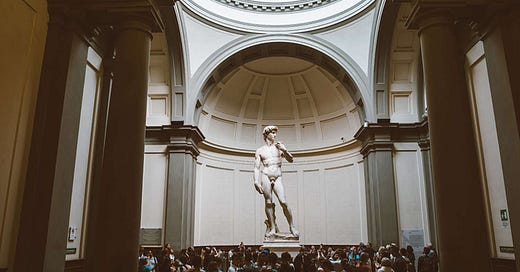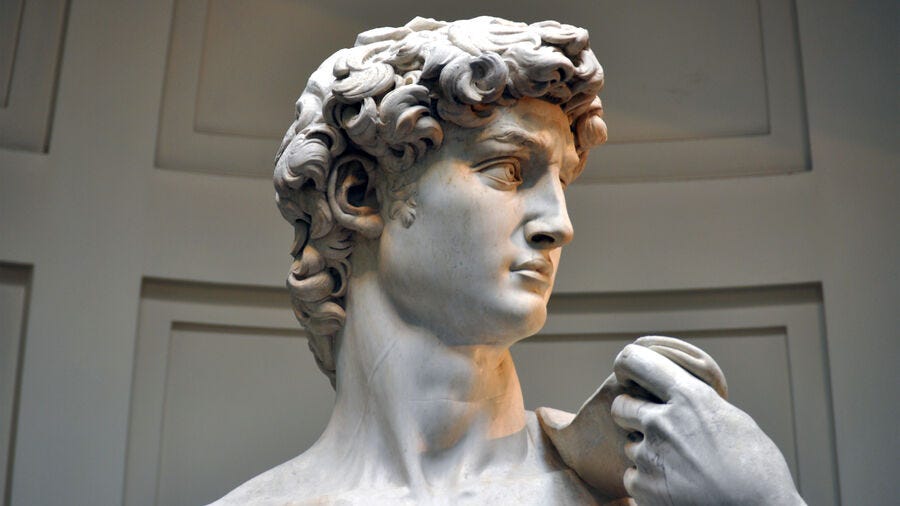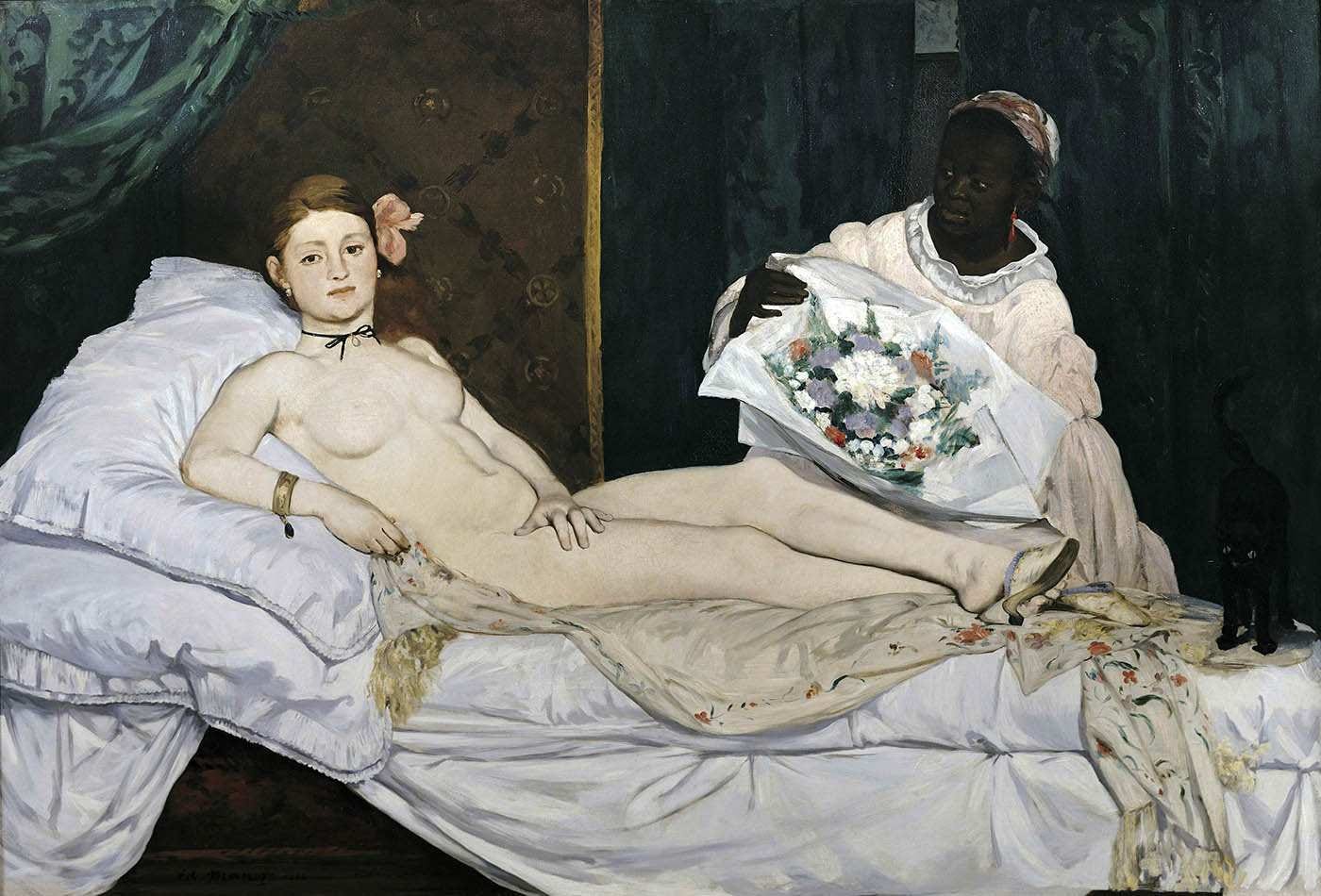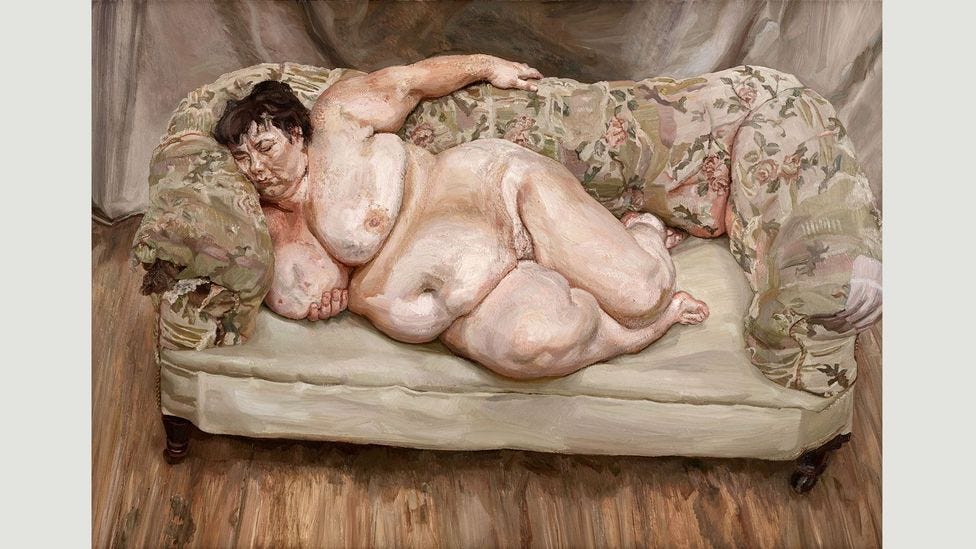I started writing this post before a teacher in Florida showed their 6th grade class images of the David (below) which subsequently resulted in the Principal resigning and the Galleria dell’Accademia and Mayor of Florence inviting said Principal, teacher and any other interested parties to come see the David in person, but it seems like a great time to discuss nudity in art. I’ve edited my original post accordingly, I hope you enjoy!
Being naked in public is taboo. Looking at naked pictures in public definitely falls into the category of taboo. Why then has artwork featuring naked people been completely acceptable for thousands of years, and why do artists continue to make so much artwork featuring nudes?
Of course this is a complicated question, but at least one answer is clear: bragging rights.
It’s about skill.
Bear with me… look down at your hand and think of how you’d draw or sculpt it to make it realistic looking. If you’re feeling really wild, spend a few minutes drawing said hand and then come back to me. OK, go!
Whether or not you did some drawing, I suspect you have an idea of how difficult it would be to draw a convincing hand. If you did draw, I am confident of this.
Let’s now look at David’s hand (below). THAT IS MARBLE. We’re looking at a hand-carved sculpture dating from 1504 of a wildly oversized man (17 feet tall) whose proportions and features are not only believable but look like he could come to life.
Artists can be pretty competitive, and believe it or not, some of us have pretty big egos. The thing about the human figure is that we all see it every single day and know exactly what it should look like. Whether or not you’re an art or visual person, a split second glance at artwork depicting a human figure is all it takes for you to determine if it’s convincing. After Michelangelo carves a figure from a block of marble that looks like that, no one is going to question his skill.
Now, with last week’s drama in Florida in mind, I feel like it’s a good time to talk about what we might and might not want to consider pornographic. I’ll start by saying I recognize that I’m 100% biased and every parent gets to do what they want, BUT one of the parents referred to the David as pornographic, and to be honest, I’m annoyed by it. A body is a body is a body. It becomes “pornographic” when we sexualize it. David isn’t standing with, gird your loins here, an erect penis. David is not doing anything remotely sexual. He’s just naked. In fact, this is the biblical David we’re looking at, who defeated Goliath. The sculpture was originally commissioned for the Florence Cathedral but ended up in front of the Plaza Vecchio, or town hall, because of its magnificence and weight.
David is meant to represent the ideal man who just defeated a giant, and he stands there proudly with his perfect muscle definition and loose curls. My (very strong) opinion here is that when we project our own shame/embarrassment/discomfort on something that is not actually sexual, not only are we instilling body shame into our children, but we’re sexualizing things that do not need to be put in that *very complicated* category to begin with. Let’s remind ourselves that it’s not Michaelangelo’s fault you think the David is a babe, it’s biology.
Ok, rant over, back to the art. Here’s where things get tricky. It’s not always just about showing off skill. Often in artwork (especially old artwork) nudes represented the ideal figure at the time, as well as beauty. Instead of focusing the rest of our chat on those artworks though, let’s talk about the ones that were meant to push the viewer.
Here’s a painting (above) which was intentionally pornographic in its day, Olympia. When Olympia was presented at the Salon (the salon was the official exhibit of the Académie des Beaux-Arts in Paris and THE exhibit of the Western world at the time) people were scandalized. Manet referenced the famous Venus of Urbino by Titian, which was considered sensual and seductive but also had references to modesty, marriage and fidelity. In Olympia though, he replaces Venus with a prostitute (several items in the painting, including her slippers, would’ve signified this to a viewer at the time). Olympia looks directly at the viewer in a more “confrontational” manner than the teasing Venus, and even Manet’s style of painting - more rough, fast and bold - impacted the painting’s reception.
None of this would’ve come as a surprise to Manet, who as a modernist painter strove to remove the idealism from art and present a more realistic version of life.
In a similar vein, I LOVE Lucian Freud’s Benefits Supervisor Sleeping series (one image below):
This painting is meant to push standards of beauty and challenge our conceptions. In a world in which we’re served magazine spreads full of petite and muscular women, Freud wants us to reconsider what an ideal woman looks like while also showing off his skill. As Christie’s auction house describes another painting in the series, “…this remarkably candid portrait is a stunning essay on Freud’s patient painterly practice, in which he undertakes an exhaustive examination of the human form and renders every curve, fold, blemish and contour of Tilley’s body with a disquieting and deeply evocative force.”
I could talk about this for hours — and pages — but I’m hopeful this gave you a small taste of how complicated the nude is in art, and a reminder that it’s not always about sex.
To learn more about the work featured above start here:
Michelangelo’s David from the Accademia
Manet and His Influence from The National Gallery of Art
Lucian Freud and Sue Tilley (the artist’s model) from BBC
Let’s talk more next week! xox








